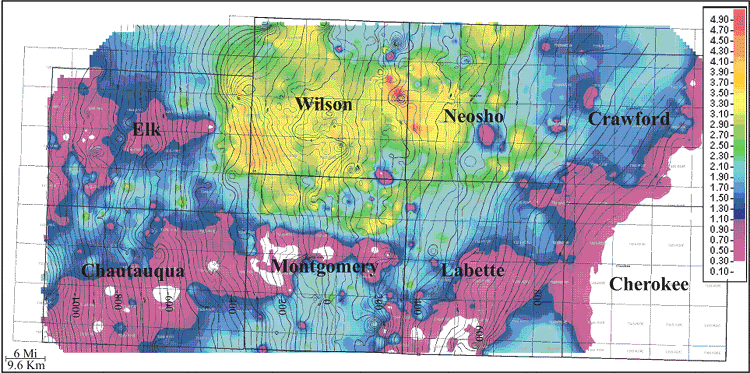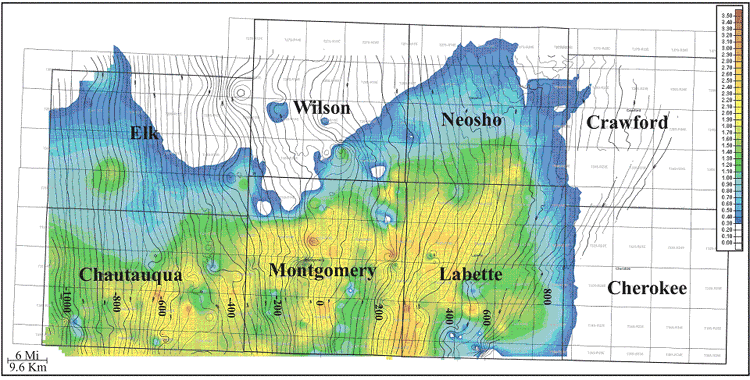 |
|
Kansas Geological Survey Open-file Report 2003-82 |
2.3.10 Bevier Interval
Description
The interval from the top of the V-Shale shale to the top of the Bevier shale ranges in thickness from 5 to 24 feet with an average of 14 feet (1.5 to 7.3 m, average of 4.3 m; Figures 2.01 and 2.28). In ascending order, the Bevier interval consists of a bioclastic mudstone to wackestone facies passing upward into a dark gray shale facies overlain by a 5 to 10 feet of thick (1.5 to 3 m) interlaminated sandstone and siltstone facies. The Bevier interval is capped by a blocky mudstone facies, coal facies (Bevier coal), and a dark shale facies (Bevier shale marker; Figure 2.28). An unconformity is located at the base of the interlaminated siltstone and sandstone facies below the Bevier coal.
Bevier and Lower Excello Interval |
 |
| Figure 2.28 - Depositional sequence and log characteristics of the Bevier and Lower Excello interval, based on core and well log from the Cooper CW#1 well 11-T35S-R18E, Labette County, Kansas (scale in feet). See Figure 2.15a for legend. |
Bevier Coal Isopach Map
A shale marker is present above the Bevier coal and is recognizable on logs
due to a relatively high gamma ray response (> 105 API units) and low neutron
response (~ 475 neutron counts) followed down hole by a lower response (<
90 API units) associated with the Bevier coal (Figure 2.28). The Bevier coal
marker extends through most the Cherokee basin. If present, the Bevier coal
is the next coal stratigraphically below the Iron Post coal.
Detailed isopach mapping of the Bevier coal reveals a coal that is discontinuous in the southern half of the study area and has a consistency in thickness over an average of 6 square miles (9.6 km2) in the northern half of the study area (Figure 2.29). Thickness of the Bevier coal ranges can be up to 4.5 feet with an average of 1.5 feet and has a normal distribution (1.4 m, average of 0.5 m). The Bevier coal exhibits a lenticular geometry that is oriented parallel to depositional dip (southwest). Structure appears to influence coal thickness. The Bevier coal appears to thicken on highs and thin into lows as defined by structure contours of the base of the Bevier coal overlain onto an isopach of Bevier coal thickness (Figure 2.29). The Bevier coal is consistently thicker in the northern half of the study area especially within Wilson, and Neosho counties. Localized thin trends in areas of thicker Bevier coal may be due to erosion.
Bevier Coal |
 |
| Figure 2.26 - Isopach of Bevier Coal (color) overlain with contours of bottom Bevier Coal structure (isopach CI:0.10ft; structure CI:25ft). |
2.3.11 Excello Interval
Description
The interval from the top of the Bevier shale to the top of the Excello Shale ranges in thickness from 25 to 130 feet with an average of 63 feet (7.6 to 40 m, average of 19 m; Figures 2.01 and 2.30). Variability in interval thickness may be due to thick sandstone accumulations within the interval (up to 30 ft, 9m; Staton, 1987). The Excello interval consists of a dark gray shale facies passing upward into a blocky mudstone facies or locally discontinuous sandstone, which is known as the Squirrel Sandstone. The Squirrel Sandstone is overlain by a coal facies known as the Iron Post coal (Figure 2.30). Above the Iron Post coal is a dark gray shale facies that grades into a pyritic shale facies (Figure 2.30). Overlying the pyretic shale facies is a regionally continuous bioclastic wackestone facies that grades into a bioclastic packstone facies. This carbonate facies is known as the Breezy Hill Limestone. Locally, capping the interval is a coal to carbonaceous shale facies (Mulky coal), followed by a phosphatic black shale facies (Figure 2.30). The phosphatic black shale facies is a regionally extensive unit known as the Excello Shale.
The Excello Shale is a highly radioactive phosphatic black shale that extends throughout the Cherokee basin and mid-continent (Wanless et al., 1969). The Excello is the first highly radioactive shale in the Cherokee Group and is recognizable on logs by a high gamma ray response (> 225 API units) and low neutron response (< 325 neutron counts) followed down the hole by a lower gamma ray response (< 150 API units). The lower gamma-ray response is associated with the underlying Mulky coal or carbonaceous shale (Figure 2.30). The Iron Post coal is identifiable as either the next coal stratigraphically below the Breezy Hill Limestone or by the overlying Iron Post shale. The Iron Post shale exhibits a relatively high gamma ray response (> 105 API units) and high neutron response (~ 925 neutron counts) followed down hole by a lower gamma ray response (< 90 API units) and low neutron response (< 100 neutron counts) due to the underlying Iron Post coal. Due the close stratigraphic relationship between the Iron Post and Bevier coals, misidentification can be a problem when only one relatively thick and easily identifiable coal is present in the upper portion of the Cherokee Group. Through mapping and cross section construction, the Bevier coal is identified as the predominate of the two coals in the northern half of the study area, whereas the Iron Post coal tends to be the thicker coal in the southern half of the study area.
Iron Post Coal Isopach Map
Detailed isopach mapping of the Iron Post coal reveals a coal that is laterally
continuous and has a consistency in thickness over an average of 6 square
miles (9.6 km2; Figure 2.31). Thickness of the Iron Post coal ranges from
0 to 2.6 feet with an average of 1 foot and a distribution that is skewed
to the minimum (0 to 0.8 m, average of 0.3 m; Appendix 2). The Iron Post coal
exhibits an elongate geometry that is oriented parallel to depositional dip
(southwest). Unlike some of the other coals local structure does not appear
to influence the local thickness of coal. The Iron Post coal is consistently
thicker in the southern half of the study area, especially within Chautauqua,
Montgomery, and Labette counties.
Iron Post Coal |
 |
| Figure 2.31 - Isopach of Iron Post Coal (color) overlain with contours of top Iron Post coal structure (isopach CI:0.10ft; structure CI:25ft). |
Mulky Coal Isopach Map
Detailed isopach mapping of the Mulky coal reveals a coal that has a consistency
in thickness over an average of 3 square miles (4.8 km2; Figure 2.32). Thickness
of the Mulky coal can be up to 2.5 feet with an average of 0.75 feet and a
distribution that is skewed to the minimum (0.8 m, average of 0.2 m, Appendix
2). The Mulky coal exhibits an irregular distribution. Local structure appears
to have influenced coal thickness. When overlaying structural contours of
top Brezzy Hill Structure onto an isopach of Mulky coal thickness, the coal
appears to thicken on highs and thin into lows. The Mulky coal is consistently
thicker in areas of Montgomery, Labette, and Neosho counties. Areas and trends
of thin Mulky coal thickness may be due to non-deposition or deposition of
carbonaceous shale instead of coal.
Mulky Coal |
 |
| Figure 2.32 - Isopach of Mulky Coal (color) overlain with contours of top Brezzy Hill Limestone structure (isopach CI:0.10ft; structure CI:25ft). |
e-mail : webadmin@kgs.ku.edu
Last updated December 2003
http://www.kgs.ku.edu/PRS/publication/2003/ofr2003-82/chapter2310-1.html